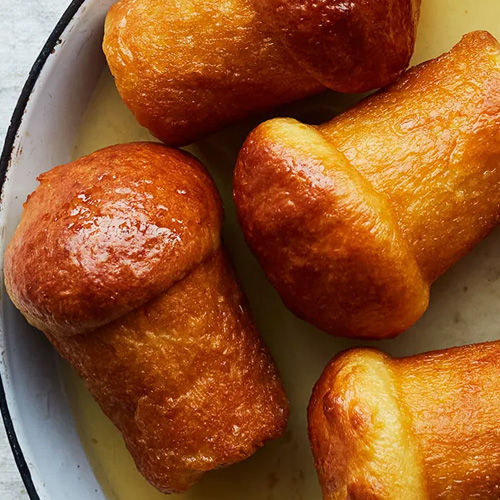Ingredients
Equipment
Instructions
Dough
- Warm the milk slightly and dissolve the yeast with a pinch of sugar.
- In a stand mixer with a dough hook, combine flour, sugar, and salt.
- Add eggs one at a time while mixing at low speed.
- Add the yeast mixture and continue mixing until dough starts to pull away from the bowl (about 10 minutes).
- Gradually add softened butter, a little at a time. Mix until the dough is smooth and elastic.
- Cover with a damp cloth and let it rise in a warm place for 2 hours, or until doubled in size.
Fill the Molds
- Grease babà molds (or muffin tin).
- Fill each mold halfway with dough.
Bake
- Preheat oven to 180°C (350°F).
- Bake for 25–30 minutes, or until golden brown and springy.
- Remove from oven, unmold, and cool on a rack.
Rum Syrup
- In a saucepan, combine water, sugar, citrus zest, and vanilla.
- Bring to a boil, simmer for 5 minutes until sugar dissolves.
- Remove from heat, stir in the rum, and let cool slightly.
Soak Babàs
- Once babàs are cool, soak them in the warm syrup for 2–3 minutes each, pressing gently to absorb.
- Remove with a slotted spoon and let drain on a rack over a tray.
- Remove with a slotted spoon and let drain on a rack over a tray. (Optional)
Serve
- Serve as-is or split and fill with pastry cream or whipped cream. Garnish with fruit, candied orange peel, or a cherry.
Notes
Use a High-Protein Flour: Bread flour or manitoba flour is ideal. It helps develop a strong gluten network, which is key to the babà’s signature elasticity and airy texture.
Don’t Rush the Kneading; The dough should be worked until it’s very elastic and slightly sticky—this can take up to 20–30 minutes in a stand mixer. A windowpane test (stretching the dough thin without tearing) helps you know it's ready.
Expect a Very Soft Dough: Babà dough is closer to a batter than a typical bread dough. Don’t be tempted to add extra flour embrace the stickiness! Grease your hands when handling the dough to avoid a mess.
Let It Rise Properly: Allow a full, patient rise until the dough doubles in size. This can take 1–2 hours depending on room temperature. A second short rise in the molds helps them puff up beautifully.
Use the Right Molds: Traditional babà molds are small, fluted metal cups, but silicone or muffin pans work too. Grease well, especially if using metal, to ensure easy release.
Bake Until Golden and Light: The babà should be deeply golden on the outside and feel light when lifted. Underbaking leaves the inside gummy; overbaking dries it out.
The Soak is Everything: A good babà should be thoroughly soaked in rum syrup inside and out but still hold its shape. Soak warm babà in warm syrup, or chilled babà in warm syrup, to help absorption.
Don’t Overdo the Rum: Add the rum after the syrup has cooled slightly to preserve its aroma. For a less boozy version, simmer the rum briefly to burn off alcohol.
